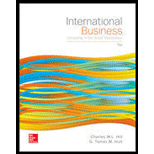
Case summary: The case investigates the incredible development of Country I's pharmaceutical industry. Over the previous decade, pharmaceutical exports from Country I have increased going from just $1 billion in the year 2000 to nearly $30 billion during the period 2012-2013. This development can be credited to the choice by numerous western firms to subcontract their manufacturing to the nation. Country I’s organizations quit delivering fake products. Secure in the learning that their licenses would be regarded; outside organizations began to work with their Country I’s partners. For Country I, the outcome has been emotional development in its pharmaceutical division. Country I, with its generally minimal effort work, huge pool of English talking researchers and labourers, and learning of Country U also, Country E drug regulations is an appealing production area for western firms. Most financial analysts worried about impact of cash trade and incentives to upgrade market development by WTO acknowledgment at Country I, particularly of Country U’s pharmaceutical market intensely managed by Federal Drug Agency (FDA), controlling substances and its impact on Country U customers. In this manner, improvement in Country I brought new open doors for Country U pharmaceutical organizations, representatives at Country I and generally Country U customers permitting to profit by medicines created at the lower research and development costs.
Characters in the case: Country I, Country U Country E.
To Discuss: The international trade theory that explains the rise of Country I’ as major exporter of pharmaceuticals.
Introduction: A pharmaceutical organization, or drug organization, is a business authorized to investigate, create, advertise as well as disseminate drugs, most normally with regards to human services.
Want to see the full answer?
Check out a sample textbook solution
Chapter IC Solutions
International Business: Competing in the Global Marketplace
- In the Crane CompanyS, indirect labor is budgeted for $86,000, and factory supervision is budgeted for $43,000 at a normal capacity of 120,000 direct labor hours. If 138,000 direct labor hours are worked, the flexible budget total for these costs is: a. $136,500.55 b. $141,904.60 c. $130,500.23arrow_forwardHi expert please give me answer general accounting questionarrow_forwardGeneral Accountingarrow_forward
- Please provide correct solution for this financial accounting questionarrow_forwardHii ticher please given correct answer general Accountingarrow_forwardDifferential Chemical produced 18,000 gallons of Preon and 39,000 gallons of Paron. Joint costs incurred in producing the two products totaled $8,500. At the split-off point, Preon has a market value of $11 per gallon and Paron $3.5 per gallon. Compute the portion of the joint costs to be allocated to Preon if the value basis is used.arrow_forward
 BUSN 11 Introduction to Business Student EditionBusinessISBN:9781337407137Author:KellyPublisher:Cengage Learning
BUSN 11 Introduction to Business Student EditionBusinessISBN:9781337407137Author:KellyPublisher:Cengage Learning Essentials of Business Communication (MindTap Cou...BusinessISBN:9781337386494Author:Mary Ellen Guffey, Dana LoewyPublisher:Cengage Learning
Essentials of Business Communication (MindTap Cou...BusinessISBN:9781337386494Author:Mary Ellen Guffey, Dana LoewyPublisher:Cengage Learning Accounting Information Systems (14th Edition)BusinessISBN:9780134474021Author:Marshall B. Romney, Paul J. SteinbartPublisher:PEARSON
Accounting Information Systems (14th Edition)BusinessISBN:9780134474021Author:Marshall B. Romney, Paul J. SteinbartPublisher:PEARSON
 International Business: Competing in the Global M...BusinessISBN:9781259929441Author:Charles W. L. Hill Dr, G. Tomas M. HultPublisher:McGraw-Hill Education
International Business: Competing in the Global M...BusinessISBN:9781259929441Author:Charles W. L. Hill Dr, G. Tomas M. HultPublisher:McGraw-Hill Education





